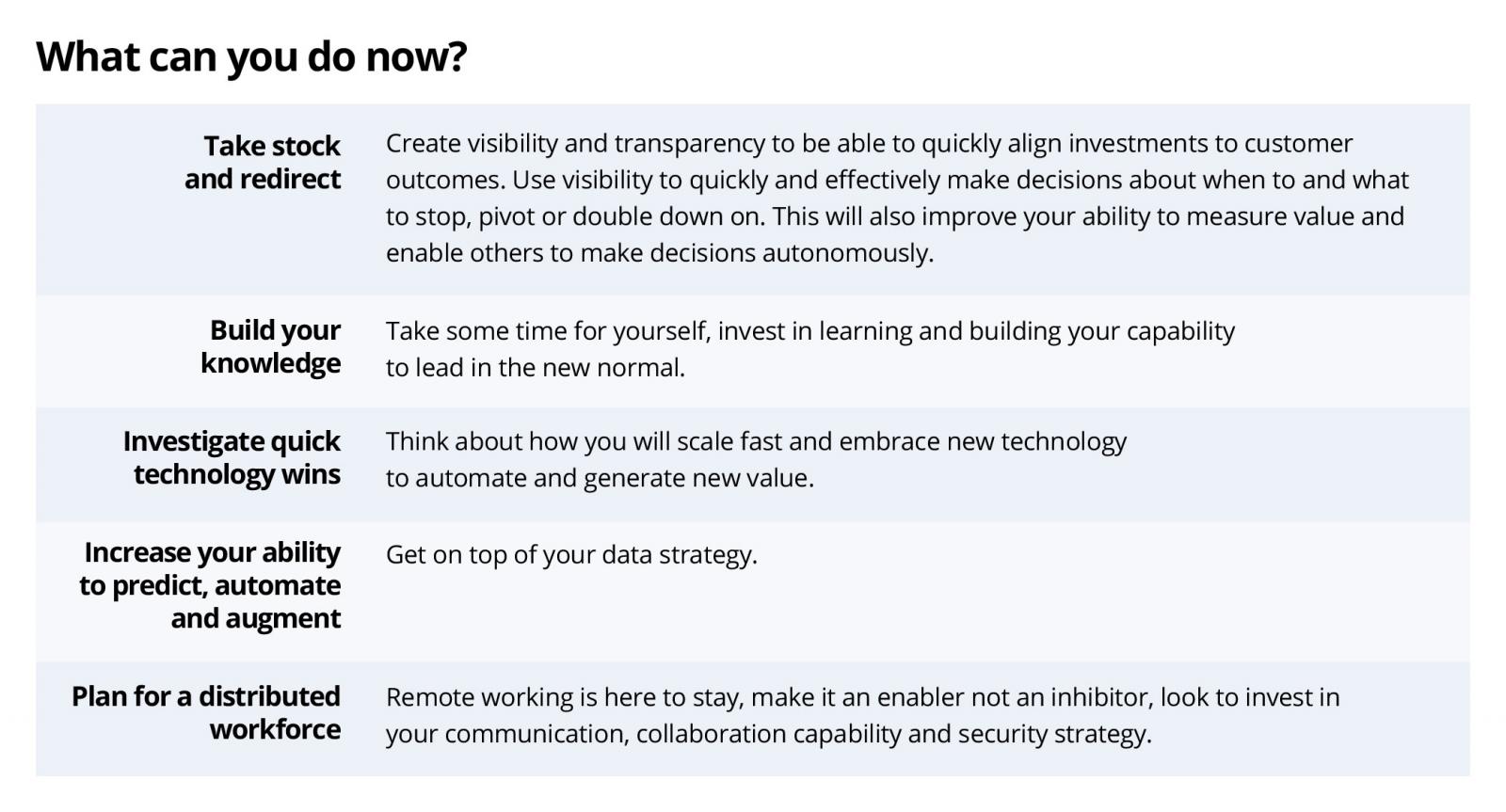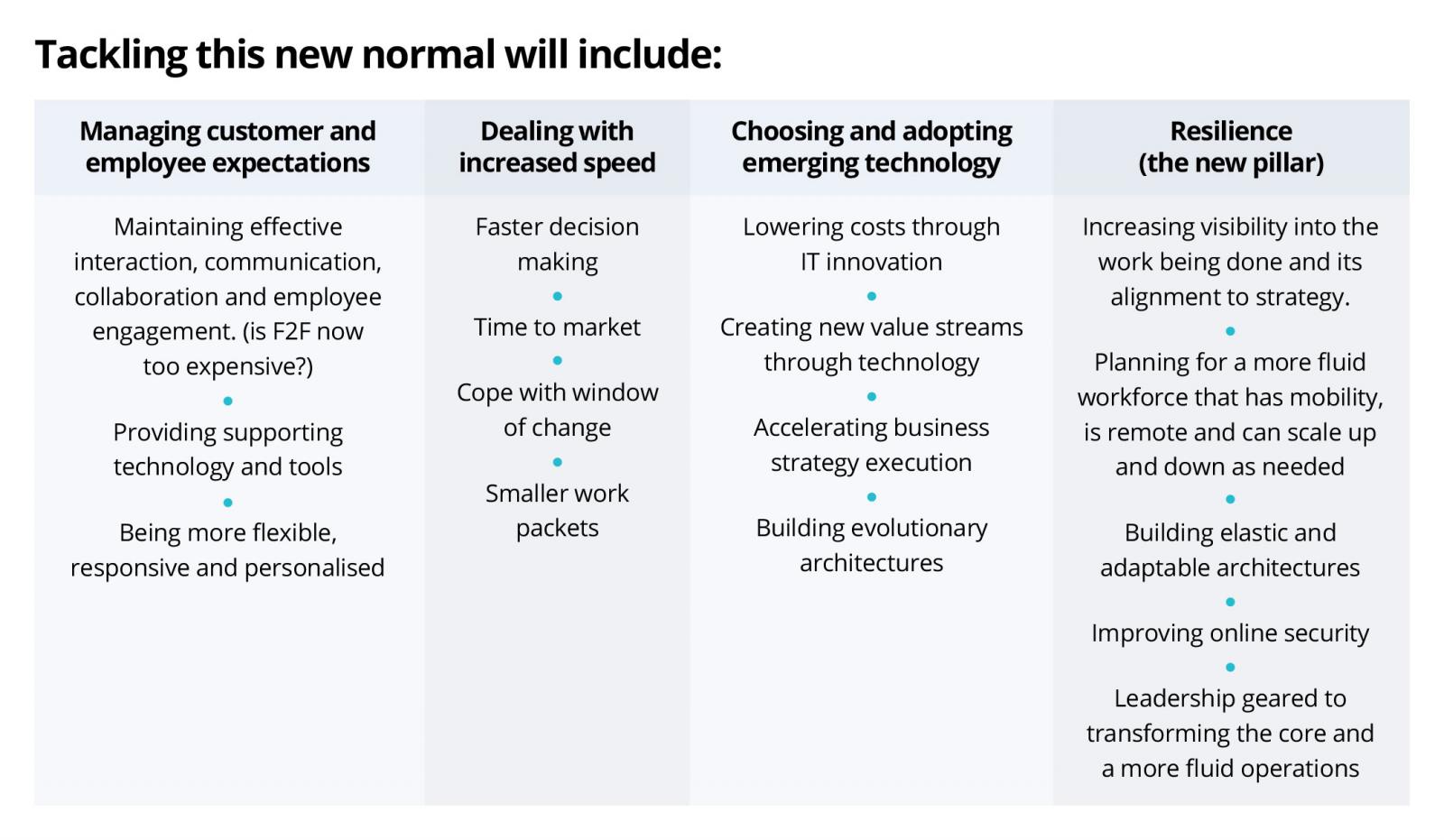
Transformation programs have stalled but the need to transform has never been greater
But the challenges faced by companies are not limited to the initial blow of COVID-19, nor the secondary waves or long lasting impact that may follow. Companies should prepare for the bounce back: the influx of value that will need to be provided to consumers once the effects of the virus wear off. Customer behavior will have changed forever, and through necessity we must all be ready to do things very differently. Now is the time to reflect on what you are doing as a company, take stock, adapt and create resilience in response to the next normal.
The repercussions of the COVID-19 pandemic have been widely reported and will therefore not be reiterated here, but if we are to take anything from the crisis, it is to make sure that we learn from it and accept a new normal where digital is dominant.
Many organizations in my hometown are responding to this crisis in a very community-minded way. It’s one of the benefits of living in a small country town; the way that we look out for each other and how members of the community support their local businesses.
The majority of stores have gone online, utilizing social media as a simple solution to provide customers with pictures of their menus, along with contact numbers and the option to order food for delivery. A local cafe has even adjusted to allow for food from a partnering restaurant to be picked up via the cafe’s drive through window.
Of course, this small example is being echoed in the larger markets and the biggest organizations more broadly too. Distilleries, like Pernod Ricard, are producing hand sanitizers, providing value to customers in new and adaptive ways beyond their core business capabilities.
COVID-19 has highlighted to us what is possible if we are willing to dive into new opportunities and how adaptive and innovative we can be, as both individuals and companies, when we are backed into a corner. It is becoming clear what a necessity really is and what we can and can’t live without.
It reminds me of a meeting I had with a group of senior leaders of a utility company a few years ago, during which a statement was made that really stuck with me.
For the majority of companies, COVID-19 has turned the lights out and we are beginning to see just how efficient and outcome-focused organizations can be in the face of adversity.
What concerns me most, however, is what happens next. There is no question that the effects of this crisis will pass. As economies recover, business and consumers will scramble for normality, creating a tsunami of demand. When it hits, many of the companies impacted by the downturn will be unable to cope with the upturn, getting a second blow that many will not recover from.
Digital divide
COVID-19 has already highlighted the digital divide between companies. Modern digital businesses, while also hurting, were better prepared to adapt as required and able to pivot for online operations and remote working. As a result, they are navigating the challenges of the crisis more successfully and are better prepared for what's next. Other companies are scrambling to find their feet or are in a huge shutdown, disengaging from transformation initiatives.
The latter are most susceptible to the double blow. In ceasing to build core business capabilities they are leaving themselves open to widening the divide, unable to capitalize on the wave of upcoming demand. In these difficult times, you don’t want to be the company that gets hit twice and risk being left with nothing.
Regardless of industry, our ways of working have changed forever. To some, this is nothing surprising. Modern digital businesses have already learned to shift with ever changing environments. What we are seeing now, as an effect of COVID-19, is the rapid pace of these changes, shortened from years to weeks, and how it is being driven predominantly by customer expectations. The shift to digital has accelerated, the fear of disruption is over, the reluctance to change now irrelevant. We are here. What will you do now?
The new normal
According to KPMG research, 80 percent of revenue growth in 2022 will hinge on digital offerings and operations. The actions you take today and in the short term, as economies recover from COVID-19, will have long lasting implications. Simply going back to the way things were will not be enough.
In my earlier example, using the cafe drive through has attracted me back to the restaurant and has opened the door to new avenues for the business to create value to their customers. Should this convenience disappear at the end of this crisis and the company revert to it's old way of working, it is highly likely that I will not visit the restaurant again in the next 12 months and an opportunity for expansion will be missed by the business.
Think of your own behavior during this crisis. How easy has it been to adjust to remote working, constantly ordering groceries and household supplies online, receiving deliveries at your door and paying bills online? We are all continuing to live relatively “normal” lives without having to leave our couch. This change is mirrored in the business world, with businesses now realizing that remote working, remote meetings and virtual interactions are not as disruptive as previously perceived. A recent conversation with a large U.S. corporation had them reflecting on how easily their staff settled into remote working and led them to question their medium-term real estate footprint.
In fact, COVID-19 has accelerated the transformation in the way we conduct business and has created “a new normal,” which we are starting to realize may be more valuable than how we were previously working.
In a recent conversation with a partner of an accounting firm, he stated that 3 weeks ago he would have been strongly against any of his employees working remotely (unless urgently required). After recently being forced to have his entire firm work from home, he was surprised to see zero change in productivity, a smooth transition into virtual meetings and interactions (with both staff and clients), and he noted that billable hours had actually increased.
Phillippa Lally, a health psychology researcher at University College London, in a study published in the European Journal of Social Psychology, found it takes just 66 days for new behaviour to become automatic. Many of the positive changes we have had to make will stick.
Transform to survive
Digital transformation has moved from a smouldering or burning platform to a burnt one. The anticipation of disruption has been replaced with the reality of disruption and what were digital strategies into digital imperatives. From protecting our health and safety, to building resilience, as well as engaging with customers and employees - all while maintaining scale and reach. Given the ever-changing dynamic of today's world (highlighted by current events), planning and investment efforts must be re-evaluated and refocused to build greater responsiveness into the business.
Now is the time to reallocate funds, instead of hoarding short-term savings made through cost-reductions in travel, physical facilities and various operational costs, and to use these funds to invest in technology, which will create more sustainable benefits for the future.
 What can you do now?
What can you do now?
Of course, for many, the short term focus is on survival and on your people, as it should be. Cost containment is prudent and many initiatives need to be wound back or stopped, but you must keep going with the work that will enable your future. Here are a few initiatives to consider: In the book, Digital Transformation Gameplan, we talk about the simplified operating model and how this makes decisions more obvious, the constraints to its adoption and the technology enablement that will accelerate your business strategy. This current crisis validates, more than ever, the need for the simplification of how you deliver value, the courageous decisions to be made to remove the largely political constraints that are holding you back and the enormous opportunity presented by modern technology approaches when it comes to you achieving your business goals.
In the book, Digital Transformation Gameplan, we talk about the simplified operating model and how this makes decisions more obvious, the constraints to its adoption and the technology enablement that will accelerate your business strategy. This current crisis validates, more than ever, the need for the simplification of how you deliver value, the courageous decisions to be made to remove the largely political constraints that are holding you back and the enormous opportunity presented by modern technology approaches when it comes to you achieving your business goals.
Take the time now, while everything is disrupted and anything is on the table, to rethink and reimagine what your transformed organization could look like. Refrain from just going back to where you were when the turn around comes. Move from a ‘if it isn’t broke, don’t fix it,’ to a ‘if I didn't need it in a crisis why put it back,’ mindset.
Disclaimer: The statements and opinions expressed in this article are those of the author(s) and do not necessarily reflect the positions of Thoughtworks.















 What can you do now?
What can you do now?

